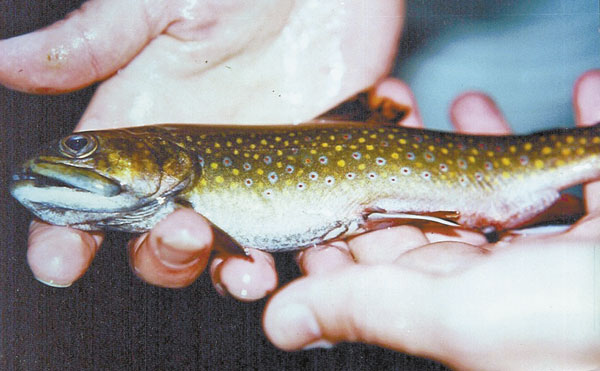
Brook trout have survived large-scale logging operations, loss of quality habitat, introduction of non-native species, ravages of nature, and overfishing since 1900. Although their numbers have declined dramatically, they have endured every threat thrown at them. However, they face one major threat that they may not be able overcome: acid precipitation.
High-elevation streams, where brook trout thrive, are increasingly becoming too acidic to sustain brook trout populations. Steve Moore, chief biologist for the Great Smoky Mountains National Park, said, “If we don’t get a handle on acid rain, we could lose our entire population (of brook trout) in the next 30 years.”
Moore and his assistant, Matt Kulp, gave an assessment of park streams and trout fishing at a public meeting in late March at Haywood Community College in Clyde. In streams around Clingman’s Dome and Mount LeConte on the Tennessee-North Carolina border, they said, brook trout have disappeared due to the high acidity of the streams, streams that have a pH of 6.0 — close to the acidity of vinegar. Acid rain precipitation is the result of nitrate (auto emissions) and sulfate (coal-fired plant emissions). Unless the nation undergoes a major shift in its dependence on fossil fuels, brook trout fishing has no reliable future.
Brook trout are the only trout native to the southern Appalachian Mountains. They once populated streams throughout the Southeast, thriving in some with elevations as low as 2,000 feet. Logging and clear-cutting resulted in siltation of streams. Trees and other vegetation were cut from streamsides, resulting in higher water temperatures.
Brook trout must have clean water, and they cannot survive in water temperatures above 68 degrees Fahrenheit. Ideal water conditions are between 54 and 63 degrees. As a result of habitat degradation, brook trout are rarely found in streams below 3,000 feet. Most surviving brook trout are relegated to marginal streams above 3,500 feet, where food is scarce and conditions are harsh.
The National Park Service is trying to delay the inevitable as long as possible. Park biologists have initiated a brook trout stream-restoration project that involves moving brook trout from endangered streams and placing them in streams that are less threatened.
The latest restoration project is Lynn Camp Prong in the Tennessee section of the park. The stream will be closed to fishing for two to three years to allow the fish to acclimate to their new habitat. All total, the park has restored sections of 10 streams.
Streams in the park and other sections of mountains contain what genetic research has identified as southern Appalachian brook trout, a distinct subspecies that differs from the fish native to the northern United States and Canada. Only about 15 percent of park streams are believed to contain these truly native brook trout.
Not all of the biologists’ report was gloomy. Kulp said park streams survived the winter in good shape. “Streams have plenty of water and lots of fish,” he said.
After being closed to fishing for 30 years, brook trout streams are not only open to fishing but to harvesting native brooks as well.
Since opening the streams, Moore said, data shows that catch-and-keep fishing “has absolutely no detrimental impact on brook trout populations.” Due to limited food and harsh weather conditions, brook trout have a life span of about three years. The biggest they get in that limited amount of time is about eight inches, and most are in the 4- to 5-inch range. Since the legal size minimum to keep a native brook trout is seven inches, a fisher can count on spending a great amount of time catching his dinner.
“We promote catch-and-keep fishing because if the fishermen don’t get them, Mother Nature will,” Moore said. Floods and drought kill anywhere from 55 to 65 percent of the brook trout population each year.
The most productive brook trout streams in the park, Moore and Kulp said, are Bunches Creek and Cataloochee Creek in the North Carolina section of the park and Little River on the Tennessee side. All three of these streams contain both brook and rainbow trout.




Be the first to comment